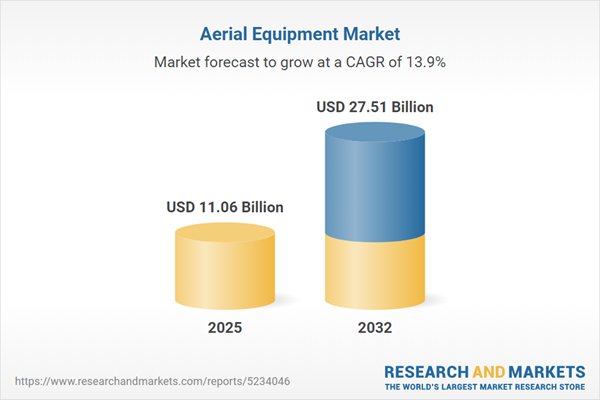Speak directly to the analyst to clarify any post sales queries you may have.
Aerial equipment is central to advancing modern infrastructure, providing essential solutions for industries facing complex access and productivity demands. This market research report enables C-level executives to make informed investments and strategic plans as the segment evolves through technological innovation and regulatory shifts.
Market Snapshot: Aerial Equipment Market Size and Growth
The aerial equipment market grew from USD 9.71 billion in 2024 to USD 11.06 billion in 2025. It is expected to continue expanding at a CAGR of 13.90%, reaching USD 27.51 billion by 2032. This growth is driven by rising adoption in construction, maintenance, warehousing, and energy industries, with businesses seeking reliable performance at elevated heights and enhanced operational safety. Senior decision-makers are navigating a sector shaped by innovation, new regulatory demands, and dynamic global trade conditions.
Scope & Segmentation of the Aerial Equipment Market
This report provides an in-depth analysis of the aerial equipment market, outlining trends across product categories, use cases, regions, and technologies:
- Equipment Types: Boom lifts (articulating and telescopic), scissor lifts, spider lifts, trailer mounted lifts, vertical mast lifts.
- Power Sources: Diesel, electric, hybrid systems.
- Height Capabilities: Platforms supporting up to 11 meters, 11 to 20 meters, and over 20 meters.
- Operation Modes: Mobile: boom lifts, spider lifts, telehandlers, trailer mounted lifts; Static: scissor lifts, vertical mast lifts.
- End User Applications: Construction, energy utilities, events and entertainment, maintenance repair, oil and gas/mining, warehousing logistics.
- Regional Coverage: Americas (North America, Latin America), Europe Middle East & Africa (Europe, Middle East, Africa), Asia-Pacific (China, India, Japan, Australia, South Korea, Southeast Asia, others).
- Technological Focus: Telematics, real-time asset tracking, predictive maintenance, automation, alternative powertrains, advanced safety systems.
Key Takeaways: Strategic Trends and Operational Insights
- Adoption of intelligent controls and ergonomic designs is addressing rising expectations for safety and operator efficiency in aerial equipment deployments.
- Connectivity through embedded sensors and analytics is standard, empowering fleet managers with actionable insights for maintenance and performance optimization.
- Companies increasingly invest in electrified and hybrid equipment to align with environmental standards and reduce carbon footprints in urban and indoor settings.
- Market participants are optimizing supply chain resilience through diversified sourcing, near-shore assembly, and digital platforms to manage inventory and pricing risks effectively.
- End-user requirements vary by sector, driving tailored solutions in training, support, and leasing to match the operational realities of industries such as construction and logistics.
Tariff Impact: Navigating Shifts in United States Trade Policy
Recent adjustments to United States tariffs have altered the aerial equipment market’s global supply chain and cost models. Manufacturers and distributors are reconfiguring sourcing agreements and logistics operations to address new import duties on key materials and subassemblies. This has prompted enhanced supplier collaboration, inventory management adjustments, and a reassessment of capital allocation strategies, particularly for rental and leasing operators managing fleet renewal and liquidity needs.
Methodology & Data Sources
The research is grounded in a combined approach of primary interviews with manufacturers, end users, and industry experts, alongside secondary intelligence from industry reports, company filings, and technical white papers. Rigorous data triangulation and peer review processes underpin the credibility and actionable validity of findings, providing a balanced perspective on both quantitative trends and qualitative drivers.
The Aerial Equipment Market: Why This Report Matters
- Facilitates informed planning for capital investment, product differentiation, and regional expansion amid technological advances and regulatory complexity.
- Identifies demand shifts, competitive dynamics, and best practices for supply chain optimization, allowing organizations to mitigate risks and harness emerging market opportunities with confidence.
Conclusion
The aerial equipment market is transforming as technological revolutions and evolving regulations reshape priorities in safety, sustainability, and supply chain strategies. Industry stakeholders can leverage the insights provided in this report to strengthen future readiness and capture value in a rapidly changing landscape.
Additional Product Information:
- Purchase of this report includes 1 year online access with quarterly updates.
- This report can be updated on request. Please contact our Customer Experience team using the Ask a Question widget on our website.
Table of Contents
3. Executive Summary
4. Market Overview
7. Cumulative Impact of Artificial Intelligence 2025
Companies Mentioned
The companies profiled in this Aerial Equipment market report include:- Terex Corporation
- Oshkosh Corporation
- Linamar Corporation
- Haulotte Group S.A.
- Manitou BF SAS
- Xuzhou Construction Machinery Group Co., Ltd.
- Zhejiang Dingli Machinery Co., Ltd.
- Shandong Sinoboom Vehicle Co., Ltd.
- Niftylift Ltd.
- SANY Heavy Industry Co., Ltd.
Table Information
| Report Attribute | Details |
|---|---|
| No. of Pages | 186 |
| Published | October 2025 |
| Forecast Period | 2025 - 2032 |
| Estimated Market Value ( USD | $ 11.06 Billion |
| Forecasted Market Value ( USD | $ 27.51 Billion |
| Compound Annual Growth Rate | 13.9% |
| Regions Covered | Global |
| No. of Companies Mentioned | 11 |









